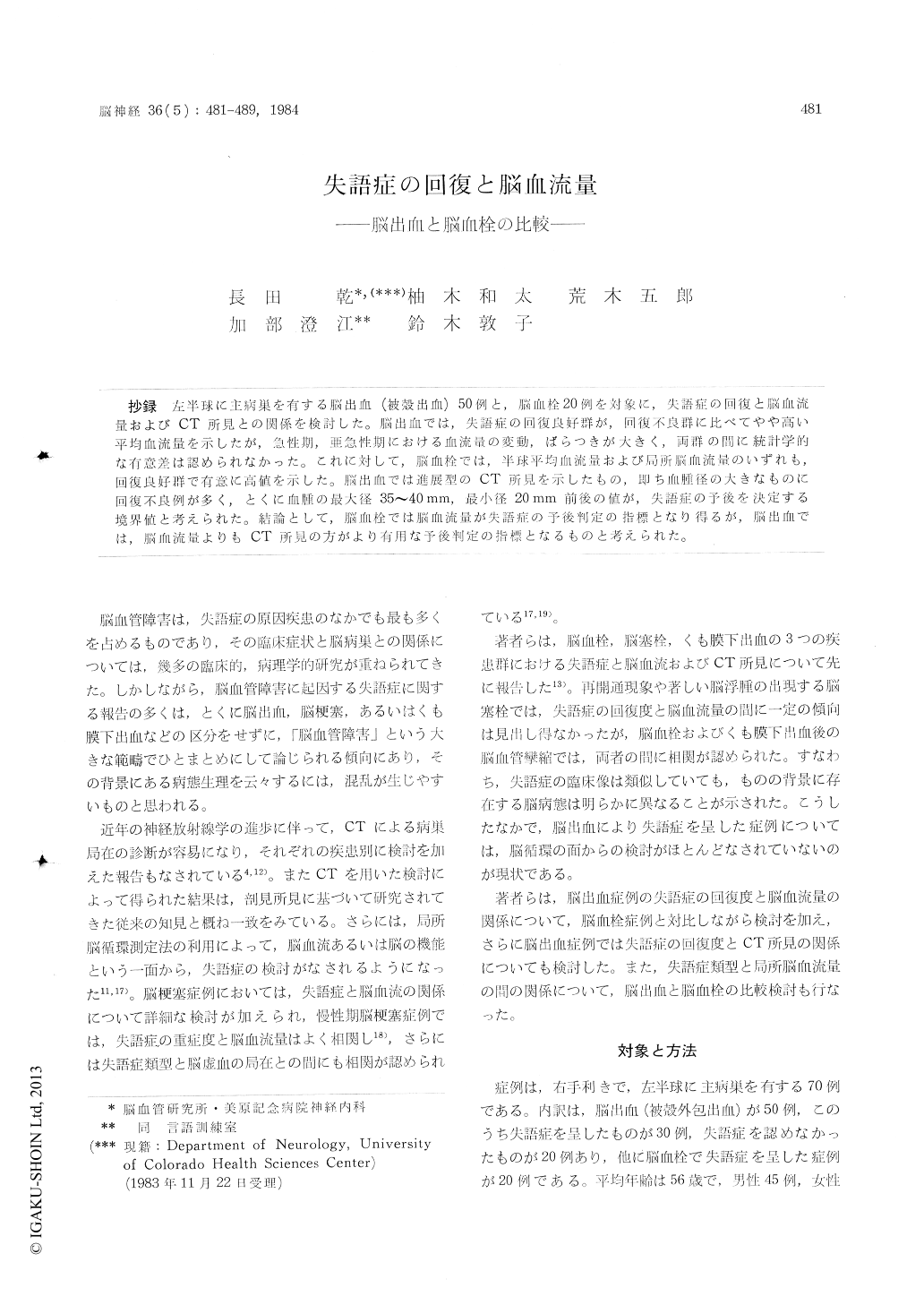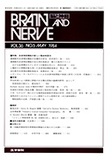Japanese
English
- 有料閲覧
- Abstract 文献概要
- 1ページ目 Look Inside
抄録 左半球に主病巣を有する脳出血(被殻出血)50例と,脳血栓20例を対象に,失語症の回復と脳血流量およびCT所見との関係を検討した。脳出血では,失語症の回復良好群が,回復不良群に比べてやや高い平均血流量を示したが,急性期,亜急性期における血流量の変動,ばらつきが大きく,両群の間に統計学的な有意差は認められなかった。これに対して,脳血栓では,半球平均血流量および局所脳血流量のいずれも,回復良好群で有意に高値を示した。脳出血では進展型のCT所見を示したもの,即ち血腫径の大きなものに回復不良例が多く,とくに血腫の最大径35〜40mm,最小径20mm前後の値が,失語症の予後を決定する境界値と考えられた。結論として,脳血栓では脳血流量が失語症の予後判定の指標となり得るが,脳出血では,脳血流量よりもCT所見の方がより有用な予後判定の指標となるものと考えられた。
To compare cerebral circulation in aphasic pa-tients who had cerebral hemorrhage against those who with cerebral thrombosis, we studies 50 pa-tients with hypertensive intracranial (putaminal) hemorrhage and 20 patients with cerebral throm-bosis whose diagnoses were confirmed on repeated CT scan and cerebral angiography. The measure-ments of regional cerebral blood flow (rCBF) by the 133Xe intraarterial injection method was car-ried out in 40 patients. The evolution of the apha-sic syndrome was analyzed according to Hirano's classification and the patients were divided into two groups : those having a favorable recovery from aphasia ; those with a poor recovery.
Twelve out of 20 patients with cerebral hemor-rhage showed a favorable recovery from aphasia, whose left hemispheric mean blood flow (mCBF) was 33.1±9.7ml/100 g/min. The mCBF was 30.8 ±10.3ml/100g/min in 8 patients with a poor re-covery. There was no significant difference in mCBF values between the two groups. The favo-rable recovery group showed slightly higher regional values in the left frontal and temporal lobes than did the poor recovery group, but no significant difference was found between the two group. Here, rCBF values failed to correlate between the two kinds of recovery from aphasia in patients with cerebral hemorrhage. The marked variability in rCBF values in the acute stage might partly account for the poor correlation in cerebral hemorrhage.
In contrast, a series of rCBF studies demon-strated that rCBF values stabilized in the acute and subacute stage in cerebral thrombosis. Nine out of 20 patients with cerebral thrombosis had a favorable recovery from aphasia. The average of mCBF was 38.2±8.5ml/100 g/min in the fa-vorable recovery group, which was significantly higher than in the poor recovery group (21.8±4.9 ml/100g/min) (p<0.05). A significant difference was also found in the regional blood flow values in the left frontal and temporal regions between the two groups (p<0. 05). Thus, rCBF values clearly paralleled the outcome of aphasia, and the rCBF value was considered to be a useful index for the prognosis of aphasia in cerebral thrombosis.
Three out of 18 patients who showed hematomas of localized type on CT had aphasia, and 22 out of 27 patients who showed hematomas with de-strunction of internal capsule on CT had aphasia, 11 of whom showed a poor recovery from aphasia. All patients who showed hematomas ruptured into ventricles had a poor recovery. The outcome ofaphasia correlated with the advancement of the hematoma on CT.
The hematoma was larger than 35mm in its maximum diameter in 80% of the patients with aphasia, and that was smaller than 35 mm in its maximum diameter in 85% of those without aphasia. Furthermore, the minimum diameter of the hematoma was longer than 20mm in all patients having a poor recovery from aphasia, and the maximum diameter was longer than 40mm in 94% of those with a poor recovery. Thus, there was a good correlation between the size of hematoma on CT and the outcome of aphasia in cerebral hemorrhage. A hematoma as large as 35 to 40mm in its maximum diameter was thought to be a critical size for a good prognosis of aphasia.
The regional blood flow values in the left fron-tal region (F) was slightly lower than those in the left temporal region (T) in the patients with global aphasia and those with amnestic aphasia due to cerebral hemorrhage. There was no obvious difference between F and T in those with motor aphasia and those with sensory aphasia. In cereb-ral thrombosis, T was lower than F in those with sensory aphasia, while those with global aphasia, motor aphasia and amnestic aphasia showed no obvious difference between the two regional values.
In conclusion, rCBF values may be a good in-dicator for a prognosis of aphasia in cerebral thrombosis. However, in cerebral hemorrhage CT findings may be a useful information for prognosis of aphasia rather than rCBF values.

Copyright © 1984, Igaku-Shoin Ltd. All rights reserved.


